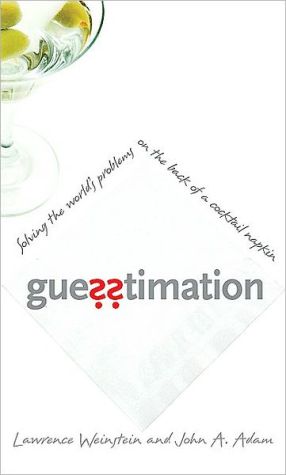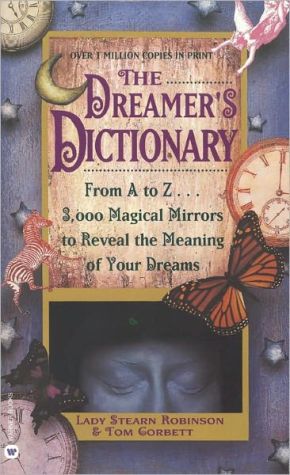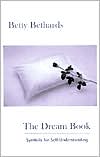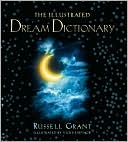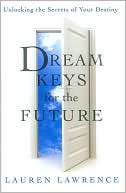Guesstimation: Solving the World's Problems on the Back of a Cocktail Napkin
Guesstimation is a book that unlocks the power of approximation—it's popular mathematics rounded to the nearest power of ten! The ability to estimate is an important skill in daily life. More and more leading businesses today use estimation questions in interviews to test applicants' abilities to think on their feet. Guesstimation enables anyone with basic math and science skills to estimate virtually anything—quickly—using plausible assumptions and elementary arithmetic.\ Lawrence Weinstein...
Search in google:
"Guesstimation is a delightful book that, page after page, gleams with insight into the measure of all things—from house pets to lottery tickets and from the kitchen to the cosmos. Meanwhile, the authors cleverly teach you some fundamental chemistry, physics, and biology, leaving you enlightened and curiously comfortable with all that once seemed intractable in the world."—Neil deGrasse Tyson, astrophysicist at the American Museum of Natural History, author of Death by Black Hole: And Other Cosmic Quandaries"Wow, I suddenly grasped concepts that have eluded me for a lifetime. If you work anywhere in the professional world and are aiming for the corner office, this little book could have significant impact on both your analytical abilities and the way you are perceived by others. An absolute eye-opener!"—Martin Yate, New York Times best-selling author of the Knock 'Em Dead job-search and career-management books"In a world where we are constantly bombarded with quantitative information (and disinformation) and where implausible factoids become established truths by repetition, acquiring a sound grounding in 'numeric literacy' has almost become a civic duty. Weinstein and Adam show to us that it can also be fun! An extremely useful book—not just for the intelligent layperson, but for virtually everyone: politicians, students, policymakers and, yes, sometimes even physicists."—Riccardo Rebonato, Royal Bank of Scotland, author of Plight of the Fortune Tellers"As well as giving insight into how scientists think, this book packs in more amazing facts than you could shake a stick at. Learn the technique of 'guesstimation' and you will be able to astound your friends at parties, as well as avoid getting ripped off by misleading advertising claims. You may even be able to work out how many facts you can shake a stick at."—John Gribbin, author of Deep Simplicity: Bringing Order to Chaos and Complexity"A very interesting and informative work, showing both how important and how easy it can be to estimate magnitudes. This book will amuse you while it instructs."—Gino Segrè, author of A Matter of Degrees"This is definitely my kind of book. The authors show, using numerous examples, how readers can make numerical estimates of quantities—some absurd and some fascinating—in a wide variety of areas. This is a very useful talent—be it in everyday life, in one's career, or in job interviews."—Robert Ehrlich, author of Eight Preposterous Propositions"This book will benefit teachers and students in science and engineering, from grade school to college. The problems are well chosen to illustrate increasingly complex themes, culminating in energy conservation, risk assessment, and environmental problems. The solutions are careful, complete, and illuminating. General readers with a taste for mathematical puzzles will enjoy it."—Hans Christian von Baeyer, author of The Fermi Solution Marion Deutsche Cohen - Mathematical Intelligencer [I]t's quite obvious that the authors intend their book to be fun, nonthreatening, and user-friendly. There's very little not to like. . . . [T]he book can be for everybody, 'higher-up professionals' who might know math but not physics, as well as students wrestling with 'word problems.' Teachers could very well recommend it to math majors and nonmajors alike, or even use it in the classroom, in some cases as supplementary reading for the course.
Guesstimation \ \ By Lawrence Weinstein John A. Adam Princeton University Press \ Copyright © 2008 Princeton University Press\ All right reserved.\ ISBN: 978-0-691-12949-5 \ \ \ Chapter One STEP 1: Write down the answer. In other words, come up with a reasonably close solution. This is frequently all the information you need. \ For example, if it is 250 miles from New York to Boston, how long will it take to drive? You would immediately estimate that it should take about four or five hours, based on an average speed of 50-60 mph. This is enough information to decide whether or not you will drive to Boston for the weekend. If you do decide to drive, you will look at maps or the Internet and figure out the exact route and the exact expected driving time.\ Similarly, before you go into a store, you usually know how much you are willing to spend. You might think it is reasonable to spend about $100 on an XGame2. If you see it for $30, you will automatically buy it. If it sells for $300, you will automatically not buy it. Only if the price is around $100 will you have to think about whether to buy it.\ We will apply the same reasoning here. We'll try to estimate the answer to within a factor of ten. Why a factor of ten? Because that is good enough to make most decisions.\ Once you have estimated the answer to a problem, the answer will fall into one of the three "Goldilocks" categories:\ 1. too big\ 2. too small\ 3. just right\ If the answer istoo big or too small, then you know what to do (e.g., buy the item, don't drive to Boston). Only if the answer is just right will you need to put more work into solving the problem and refining the answer. (But that's beyond the scope of this book. We just aim to help you estimate the answer to within a factor of ten.)\ If all problems were as simple as that, you wouldn't need this book. Many problems are too complicated for you to come up with an immediate correct answer. These problems will need to be broken down into smaller and smaller pieces. Eventually, the pieces will be small enough and simple enough that you can estimate an answer for each one. And so we come to\ STEP 2: If you can't estimate the answer, break the problem into smaller pieces and estimate the answer for each one. You only need to estimate each answer to within a factor of ten. How hard can that be?\ It is often easier to establish lower and upper bounds for a quantity than to estimate it directly. If we are trying to estimate, for example, how many circus clowns can fit into a Volkswagen Beetle, we know the answer must be more than one and less than 100. We could average the upper and lower bounds and use 50 for our estimate. This is not the best choice because it is a factor of 50 greater than our lower bound and only a factor of two lower than our upper bound.\ Since we want our estimate to be the same factor away from our upper and lower bounds, we will use the geometric mean. To take the approximate geometric mean of any two numbers, just average their coefficients and average their exponents. In the clown case, the geometric mean of one ([10.sup.0]) and 100 ([10.sup.2]) is 10 ([10.sup.1]) because one is the average of the exponents zero and two. Similarly, the geometric mean of 2 x [10.sup.15] and 6 x [10.sup.3] is about 4 x [10.sup.9] (because 4 = 2+6/2 and 9 = 15+3/2). If the sum of the exponents is odd, it is a little more complicated. Then you should decrease the exponent sum by one so it is even, and multiply the final answer by three. Therefore, the geometric mean of one and [10.sup.3] is 3 x [10.sup.1] = 30.\ EXAMPLE 1: MongaMillions Lottery Ticket Stack\ Here's a relatively straightforward example: Your chance of winning the MongaMillions lottery is one in 100 million. If you stacked up all the possible different lottery tickets, how tall would this stack be? Which distance is this closest to: a tall building (100 m or 300 ft), a small mountain (1000 m), Mt Everest (10,000 m), the height of the atmosphere ([10.sup.5] m), the distance from New York to Chicago ([10.sup.6] m), the diameter of the Earth ([10.sup.7] m), or the distance to the moon (4x [10.sup.8]m)? Imagine trying to pick the single winning ticket from a stack this high.\ Solution: To solve this problem, we need two pieces of information: the number of possible tickets and the thickness of each ticket. Because your chance of winning is one in 100 million, this means that there are 100 million ([10.sup.8]) possible different tickets. We can't reliably estimate really thin items like a single lottery ticket (is it 1/16 in. or 1/64 in.? is it 1 mm or 0.1 mm?) so let's try to get the thickness of a pack of tickets.\ Let's think about packs of paper in general. One ream of copier or printer paper (500 sheets) is about 1.5 to 2 in. (or about 5 cm since 1 in. = 2.5cm) but paper is thinner than lottery tickets. A pack of 52 playing cards is also about 1 cm. That's probably closer. This means that the thickness of one ticket is\ t = 1 cm/52 tickets = 0.02 cm/ticket x 1 m/[10.sup.2] cm\ = 2 x [10.sup.-4] m/ticket\ Therefore, the thickness of [10.sup.8] tickets is\ T = 2 x [10.sup.-4] m/ticket x [10.sup.8] tickets = 2 x [10.sup.4] m\ 2 x [10.sup.4] m is 20 kilometers or 20 km (which is about 15 miles since 1 mi = 1.6km).\ If stacked horizontally, it would take you four or five hours to walk that far.\ If stacked vertically, it would be twice as high as Mt Everest (30,000 ft or 10 km) and twice as high as jumbo jets fly.\ Now perhaps you used the thickness of regular paper so your stack is a few times shorter. Perhaps you used 1 mm per ticket so your stack is a few times taller. Does it really matter whether the stack is 10 km or 50 km? Either way, your chance of pulling the single winning ticket from that stack is pretty darn small.\ EXAMPLE 2: Flighty Americans\ These problems are great fun because, first, we are not looking for an exact answer, and second, there are many different ways of estimating the answer. Here is a slightly harder question with multiple solutions.\ How many airplane flights do Americans take in one year?\ We can estimate this from the top down or from the bottom up. We can start with the number of airports or with the number of Americans.\ Solution 1: Start with the number of Americans and estimate how many plane flights each of us take per year. There are 3 x [10.sup.8] Americans. Most of us probably travel once a year (i.e., two flights) on vacation or business and a small fraction of us (say 10%) travel much more than that. This means that the number of flights per person per year is between two and four (so we'll use three). Therefore, the total number of flights per year is\ N = 3 x [10.sup.8] people x 3 flights/person-year = 9 x [10.sup.8] passengers/year\ Solution 2: Start with the number of airports and then estimate the flights per airport and the passengers per flight. There are several reasonable size airports in a medium-sized state (e.g., Virginia has Dulles, Reagan-National, Norfolk, Richmond, and Charlottesville; and Massachusetts has Boston and Springfield). If each of the fifty states has three airports then there are 150 airports in the US. Each airport can handle at most one flight every two minutes, which is 30 flights per hour or 500 flights per 16-hour day. Most airports will have many fewer flights than the maximum. Each airplane can hold between 50 and 250 passengers. This means that we have about\ N = 150 airports x 100 flights/ airport-day x 100 passengers/flight\ x 365 days/year = 5 x [10.sup.8] passengers per year\ Wow! Both methods agree within a factor of two.\ The actual number of US domestic airline passengers in 2005 was 6.6 x [10.sup.8], which is close enough to both answers.\ EXAMPLE 3: Piano Tuners in Los Angeles\ Now let's work out a harder problem.\ How many piano tuners are there in Los Angeles (or New York or Virginia Beach or your own city)? This is the classic example originated by Enrico Fermi and used at the beginning of many physics courses because it requires employing the methods and reasoning used to attack these problems but does not need any physics concepts.\ Solution: This is a sufficiently complicated problem that we cannot just estimate the answer. To solve this, we need to break down the problem. We need to estimate (1) how many pianos there are in Los Angeles and (2) how many pianos each tuner can care for. To estimate the number of pianos, we need (1) the population of the city, (2) the proportion of people that own a piano, and (3) the number of schools, churches, etc. that also have pianos. To estimate the number of pianos each tuner can care for, we need to estimate (1) how often each piano is tuned, (2) how much time it takes to tune a piano, and (3) how much time a piano tuner spends tuning pianos.\ This means that we need to estimate the following:\ 1. population of Los Angeles\ 2. proportion of pianos per person\ 3. how often each piano is tuned per year\ 4. how much time it takes to tune each piano\ 5. how much time each piano tuner works per year\ Let's take it from the top.\ 1. The population of Los Angeles must be much less than [10.sup.8] (since the population of the US is 3 x [10.sup.8]). It must be much more than [10.sup.6] (since that is the size of an ordinary big city). We'll estimate it at [10.sup.7].\ 2. Pianos will be owned by individuals, schools, and houses of worship. About 10% of the population plays a musical instrument (it's surely more than 1% and less than 100%). At most 10% of musicians play the piano and not all of them own a piano so the proportion that own a piano is probably 2-3% of the musicians. This would be 2 x [10.sup.-3] of the population. There is about one house of worship per thousand people and each of those will have a piano. There is about one school per 500 students (or about 1 per 1000 population) and each of those will have a piano. This gives us about 4 or 5 x [10.sup.-3] pianos per person. Thus, the number of pianos will be about [10.sup.7] x 4 x [10.sup.-3] = 4 x [10.sup.4].\ 3. Pianos will be tuned less than once per month and more than once per decade. We'll estimate once per year.\ 4. It must take much more than 30 minutes and less than one day to tune a piano (assuming that it is not too badly out of tune). We'll estimate 2 hours. Another way to look at it is that there are 88 keys. At 1 minute per key, it will take 1.5 hours. At 2 minutes per key, it will take 3 hours.\ 5. A full-time worker works 8 hours per day, 5 days per week, and 50 weeks per year which gives 8 x 5 x 50 = 2000 hours. In 2000 hours she can tune about 1000 pianos (wow!).\ This means that the 4 x [10.sup.4] pianos need 40 piano tuners.\ How close are we? Well, the Yellow Pages for our city of [10.sup.6] inhabitants (ten times fewer than LA) has 16 entries under the heading of "Pianos-Tuning, Repairing & Refinishing." There are probably only one or two tuners per entry and they probably do not spend full time tuning. This means that our estimate is probably too low by a factor of five. However, that is a LOT closer than we could get by just guessing.\ Remember that we are only trying to estimate the answer within a factor of ten.\ (Continues...)\ \ \ \ \ Excerpted from Guesstimation by Lawrence Weinstein John A. Adam\ Copyright © 2008 by Princeton University Press. Excerpted by permission.\ All rights reserved. No part of this excerpt may be reproduced or reprinted without permission in writing from the publisher.\ Excerpts are provided by Dial-A-Book Inc. solely for the personal use of visitors to this web site. \ \
Acknowledgments xi Preface xiii Chapter 1: How to Solve Problems 1 Chapter 2: Dealing with Large Numbers 11 2.1 Scientific Notation 11 2.2 Accuracy 14 2.3 A Note on Units 16 2.4 Unit Conversion 17 Chapter 3: General Questions 19 3.1 One big family 21 3.2 Fore! 25 3.3 This is a fine pickle you've got us into, Patty 29 3.4 Throwing in the towel 31 3.5 Hey buddy, can you fill a dome? 35 3.6 A mole of cats 39 3.7 Massive MongaMillions 41 3.8 Tons of trash 43 3.9 Mt. Trashmore 47 3.10 Juggling people 51 3.11 Shelving the problem 53 Chapter 4: Animals and People 55 4.1 More numerous than the stars in the sky 57 4.2 Laboring in vein 61 4.3 Unzipping your skin 65 4.4 Hair today, gone tomorrow 69 4.5 Hot dawg! 73 4.6 Playing the field 75 4.7 Ewww. . . gross! 77 4.8 Going potty 79 4.9 Let's get one thing straight! 83 Chapter 5: Transportation 87 5.1 Driving past Saturn 89 5.2 Drowning in gasoline 91 5.3 Slowly on the highway 95 5.4 Rickshaws and automobiles 99 5.5 Horse exhaust 103 5.6 Tire tracks 107 5.7 Working for the car 109 Chapter 6: Energy and Work 113 6.1 Energy of height 114 6.1.1 Mountain climbing 115 6.1.2 Flattening the Alps 119 6.1.3 Raising a building 123 6.2 Energy of motion 126 6.2.1 At your service 127 6.2.2 Kinetic trucking 129 6.2.3 Racing continents 131 6.2.4 "To boldly go. . . " 135 6.3 Work 138 6.3.1 Crash! 139 6.3.2 Spider-Man and the subway car 143 Chapter 7: Hydrocarbons and Carbohydrates 145 7.1 Chemical energy 145 7.1.1 Energy in gasoline 147 7.1.2 Battery energy 151 7.1.3 Battery energy density 155 7.1.4 Batteries vs. gas tanks 159 7.2 Food is energy 162 7.2.1 Eat here, get gas 163 7.2.2 Farmland for ethanol 167 7.3 Power! 170 7.3.1 Hot humans 171 7.3.2 Fill 'er up with gasoline 173 7.3.3 Fill 'er up with electricity 175 Chapter 8: The Earth, the Moon, and Lots of Gerbils 179 8.1 "And yet it moves" (e pur si muove) 181 8.2 Duck! 185 8.3 Super-sized Sun 189 8.4 Sun power 193 8.5 Gerbils 1, Sun 0 197 8.6 Chemical Sun 201 8.7 Nearby supernova 205 8.8 Melting ice caps 209 Chapter 9: Energy and the Environment 213 9.1 Power to the people 215 9.2 Continental power 219 9.3 Solar energy 223 9.4 Land for solar energy 225 9.5 Tilting at windmills 229 9.6 The power of coal 233 9.7 The power of nuclei 237 9.8 Hard surfaces 239 Chapter 10: The Atmosphere 243 10.1 Into thin air 245 10.2 Ancient air 247 10.3 Suck it up 251 10.4 CO2 from coal 255 10.5 A healthy glow 259 10.6 CO2 from cars 261 10.7 Turning gas into trees 265 10.8 Turning trees into gas 269 Chapter 11: Risk 273 11.1 Gambling on the road 275 11.2 The plane truth 277 11.3 Life's a beach 279 11.4 Up in smoke 281 Chapter 12: Unanswered Questions 285 Appendix: Needed Numbers and Formulas 289 A.1 Useful Numbers 289 A.2 Handy Formulas 289 A.3 Metric Prefixes 290 B Pegs to Hang Things On 291 Bibliography 295 Index 299
\ Civil EngineeringThe cumulative effect of fairly simple paths to estimating solutions to a dizzying array of difficult problems is fascinating.\ — Ray Bert\ \ \ \ \ New York Times\ - Natalie Angier\ Adam and his colleague Lawrence Weinstein, a professor of physics, offer a wide and often amusing assortment of Fermi flexes in a book that just caught my eye, Guesstimation: Solving the World's Problems on the Back of a Cocktail Napkin.\ \ \ Science\ - Stephan Mertens\ An important skill of great use . . . is the ability to derive an approximate result from insufficient data. Guesstimation is a collection of [problems] gathered from everyday life and various fields. Working out questions . . . is both entertaining and enlightening. It may also help foster your career . . . because making correct guesses quickly establishes your reputation as an expert.\ \ \ \ \ Times Higher Education\ - Tony Mann\ This book is a stimulating collection that will help the reader to reach informed judgments and will be a useful source of inspiration for mathematics and physics teachers: my only concern is that if my students have read it before they arrive at university, I may have to find a new approach to my first day's teaching.\ \ \ \ \ BBC Focus Magazine\ - Robert Matthews\ While few can hope to emulate the brilliance of a Nobel Prize winner like [Enrico] Fermi, coming up with pretty good guesstimates is a skill that can be taught. And that's the aim of Guesstimation. After a quick tutorial, the authors get down to business with a host of wide-ranging worked examples, from estimating the numbers of piano tuners in Los Angeles to figuring out the impact of deforestation on greenhouse gas levels. The results are sometimes surprising.\ \ \ \ \ BusinessWeek\ - Peter Coy\ [Guesstimation is] a left-brain book that helps you approximate answers to the types of questions actually asked in some job interviews today.\ \ \ \ \ New Scientist\ - Matthew Killeya\ [A] delightful account of mathematical approximation, which instills the beauty and power of the back-of-the-envelope calculation. The puzzles make addictive confidence builders by breaking down tricky questions into manageable parts. Never again will you take a newspaper figure at face value without feeling the need, and confidence, to guesstimate your own figure.\ \ \ \ \ Manila Times\ - Rony V. Diaz\ Guesstimation is both enlightening and entertaining. I recommend it to my fellow journalists both as a tool of our trade and as a mind stretcher.\ \ \ \ \ Choice\ - J. Johnson\ Any idea what fraction of land in the US is covered by either a roof or pavement? Known as a Fermi problem, this type of question requires the use of reasonable estimation, which is the focus of the book at hand. In the initial chapters, Weinstein and Adam briefly review good 'guesstimation' techniques involving numbers and explain why the use of the geometric mean is preferred over the arithmetic mean.\ \ \ \ \ American Journal of Physics\ - Arthur Eisenkrafr\ Physics educators can use this book as a guide to including the important skill of estimation in their courses. Students may find the power of estimation to be a valuable skill and will want to work their way through this book.\ \ \ \ \ Mathematics Teacher\ - Diane Resek\ A source of imaginative problems, this book would make a nice addition to a mathematics department library.\ \ \ \ \ Mathematical Intelligencer\ - Marion Deutsche Cohen\ [I]t's quite obvious that the authors intend their book to be fun, nonthreatening, and user-friendly. There's very little not to like. . . . [T]he book can be for everybody, 'higher-up professionals' who might know math but not physics, as well as students wrestling with 'word problems.' Teachers could very well recommend it to math majors and nonmajors alike, or even use it in the classroom, in some cases as supplementary reading for the course.\ \ \ \ \ Civil Engineering\ - Ray Bert\ The cumulative effect of fairly simple paths to estimating solutions to a dizzying array of difficult problems is fascinating.\ \ \ \ \ New York TimesDr. Adam and his colleague Lawrence Weinstein, a professor of physics, offer a wide and often amusing assortment of Fermi flexes in a book that just caught my eye, Guesstimation: Solving the World's Problems on the Back of a Cocktail Napkin.\ — Natalie Angier\ \ \ \ \ ScienceAn important skill of great use . . . is the ability to derive an approximate result from insufficient data. Guesstimation is a collection of [problems] gathered from everyday life and various fields. Working out questions . . . is both entertaining and enlightening. It may also help foster your career . . . because making correct guesses quickly establishes your reputation as an expert.\ — Stephan Mertens\ \ \ \ \ Times Higher EducationThis book is a stimulating collection that will help the reader to reach informed judgments and will be a useful source of inspiration for mathematics and physics teachers: my only concern is that if my students have read it before they arrive at university, I may have to find a new approach to my first day's teaching.\ — Tony Mann\ \ \ \ \ BBC Focus MagazineWhile few can hope to emulate the brilliance of a Nobel Prize winner like [Enrico] Fermi, coming up with pretty good guesstimates is a skill that can be taught. And that's the aim of Guesstimation. After a quick tutorial, the authors get down to business with a host of wide-ranging worked examples, from estimating the numbers of piano tuners in Los Angeles to figuring out the impact of deforestation on greenhouse gas levels. The results are sometimes surprising.\ — Robert Matthews\ \ \ \ \ BusinessWeek[Guesstimation is] a left-brain book that helps you approximate answers to the types of questions actually asked in some job interviews today.\ — Peter Coy\ \ \ \ \ New Scientist[A] delightful account of mathematical approximation, which instills the beauty and power of the back-of-the-envelope calculation. The puzzles make addictive confidence builders by breaking down tricky questions into manageable parts. Never again will you take a newspaper figure at face value without feeling the need, and confidence, to guesstimate your own figure.\ — Matthew Killeya\ \ \ \ \ Manila TimesGuesstimation is both enlightening and entertaining. I recommend it to my fellow journalists both as a tool of our trade and as a mind stretcher.\ — Rony V. Diaz\ \ \ \ \ ChoiceAny idea what fraction of land in the US is covered by either a roof or pavement? Known as a Fermi problem, this type of question requires the use of reasonable estimation, which is the focus of the book at hand. In the initial chapters, Weinstein and Adam briefly review good 'guesstimation' techniques involving numbers and explain why the use of the geometric mean is preferred over the arithmetic mean.\ — J. Johnson\ \ \ \ \ CosmosHow many people in the world are picking their nose right now? Weinstein and Adam 'guesstimate' the answer to this problem and 79 others, covering chemistry, physics, biology and history. The book is a step-by-step guide to problem-solving using rough-and-ready maths, the kind done on the back of a cocktail napkin. And the authors have kindly left additional questions at the end to get readers started on their own problem-solving expedition.\ \ \ \ \ American Journal of PhysicsPhysics educators can use this book as a guide to including the important skill of estimation in their courses. Students may find the power of estimation to be a valuable skill and will want to work their way through this book.\ — Arthur Eisenkrafr\ \ \ \ \ Mathematics TeacherA source of imaginative problems, this book would make a nice addition to a mathematics department library.\ — Diane Resek\ \ \ \ \ Mathematical Intelligencer[I]t's quite obvious that the authors intend their book to be fun, nonthreatening, and user-friendly. There's very little not to like. . . . [T]he book can be for everybody, 'higher-up professionals' who might know math but not physics, as well as students wrestling with 'word problems.' Teachers could very well recommend it to math majors and nonmajors alike, or even use it in the classroom, in some cases as supplementary reading for the course.\ — Marion Deutsche Cohen\ \ \ \ \ New York TimesDr. Adam and his colleague Lawrence Weinstein, a professor of physics, offer a wide and often amusing assortment of Fermi flexes in a book that just caught my eye, Guesstimation: Solving the World's Problems on the Back of a Cocktail Napkin.\ — Natalie Angier\ \ \ \ \ ScienceAn important skill of great use . . . is the ability to derive an approximate result from insufficient data. Guesstimation is a collection of [problems] gathered from everyday life and various fields. Working out questions . . . is both entertaining and enlightening. It may also help foster your career . . . because making correct guesses quickly establishes your reputation as an expert.\ — Stephan Mertens\ \ \ \ \ Times Higher EducationThis book is a stimulating collection that will help the reader to reach informed judgments and will be a useful source of inspiration for mathematics and physics teachers: my only concern is that if my students have read it before they arrive at university, I may have to find a new approach to my first day's teaching.\ — Tony Mann\ \ \ \ \ BusinessWeek[Guesstimation is] a left-brain book that helps you approximate answers to the types of questions actually asked in some job interviews today.\ — Peter Coy\ \ \ \ \ Manila TimesGuesstimation is both enlightening and entertaining. I recommend it to my fellow journalists both as a tool of our trade and as a mind stretcher.\ — Rony V. Diaz\ \ \ \ \ BBC Focus MagazineWhile few can hope to emulate the brilliance of a Nobel Prize winner like [Enrico] Fermi, coming up with pretty good guesstimates is a skill that can be taught. And that's the aim of Guesstimation. After a quick tutorial, the authors get down to business with a host of wide-ranging worked examples, from estimating the numbers of piano tuners in Los Angeles to figuring out the impact of deforestation on greenhouse gas levels. The results are sometimes surprising.\ — Robert Matthews\ \
